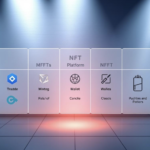Now Reading: Top Decentralized Finance Yield Farming Strategies Explained
- 01
Top Decentralized Finance Yield Farming Strategies Explained
Top Decentralized Finance Yield Farming Strategies Explained

Yield farming lets U.S. investors deploy crypto holdings to seek higher returns by staking, lending, or locking tokens for governance incentives and swap fees. The 2020 “DeFi summer” began when Compound paid COMP to users, sparking broad liquidity mining and fast growth in total value locked.
This guide breaks complex defi mechanics into clear steps. You will learn how yield farming works, which categories exist, and how to match each approach to your risk profile. Expect sections on lending and borrowing, liquidity mining on DEXs, staking, aggregators, and more advanced plays.
Rewards are never free: fees, slippage, and protocol design shape net returns. TVL rose from about $600 million in 2020 to roughly $170 billion in November 2021, and sits near $107 billion as of February 2025, showing sizable liquidity but ongoing cycles and volatility.
Read on to learn practical steps, tax and recordkeeping tips for U.S. investors, and frameworks to decide when to act and when to stay on the sidelines.
DeFi yield farming today: context, opportunity, and who this guide is for
Today’s landscape mixes big pools of capital with fast-moving protocol incentives that reshape trading and rewards.
Why yield farming surged and where TVL sits now
Compound Finance’s COMP token program in 2020 sparked a new model: pay users to supply liquidity and bootstrap markets. That move drew capital and active users into on‑chain pools and kickstarted broad token rewards.
TVL grew from about $600 million in 2020 to roughly $170 billion in November 2021, and sits near $107 billion as of February 2025 (DeFiLlama). This shows persistent liquidity but clear cycles that change headline yield and opportunity availability.

Who should consider this, and who should start small or sit out
- Good fit: hands-on investors who understand smart contract platforms, can monitor positions, and handle rebalancing.
- Start small or sit out: users with low risk tolerance, limited time, or little experience with wallets, gas fees, and on‑chain steps.
| Profile | Opportunity | Warning |
|---|---|---|
| Active trader | High APY in new pools | Impermanent loss, token volatility |
| Long-term holder | Stable rewards via staking | Incentive sustainability concerns |
| Casual investor | Simple staking or stablecoin options | Complex monitoring and rug pulls |
Practical tip: compare headline returns to simpler options and watch for red flags: unaudited protocols, concentrated tokens, or unusually high APYs tied to illiquid assets.
Yield farming fundamentals you must know before you start
Before you commit capital, understand the basic roles and building blocks that create on‑chain returns.

Key roles: liquidity providers, lenders, stakers, and borrowers
Liquidity providers deposit paired assets into DEX pools (for example Uniswap) to seed trading and earn a share of swap fees plus possible governance tokens.
Lenders supply assets to protocols like Aave or Compound to earn variable interest while enabling others to borrow.
Stakers lock tokens to secure a blockchain network or protocol and collect rewards. Borrowers post collateral to access capital but must manage liquidation risk.
Core components: LP tokens, governance tokens, and APY
Liquidity pools issue LP tokens that represent your fractional claim on a pool and on accumulated fees. Governance tokens may be emitted as incentives and give voting rights that affect protocol fees and emissions.
APY mixes interest and fee-based returns. It moves with market activity, so monitoring is essential to know if net returns match expectations.
AMMs and pricing basics: how pools enable trading and fees
Automated market makers replace order books by using algorithmic formulas inside pools. Traders swap against pooled assets, which creates fees that reward providers.
Interest on lending markets adjusts with supply and demand, making lender earnings and borrower costs variable over time. Smart contracts and blockchain performance also shape how fast and cheap you can claim rewards.
| Role | Main Revenue | Primary Risk |
|---|---|---|
| Liquidity provider | Swap fees + token incentives | Impermanent loss, token volatility |
| Lender | Variable interest | Smart contract or protocol risk |
| Staker | Staking rewards | Lock-up and slashing risk |
| Borrower | Leverage or liquidity access | Liquidation on price drops |
How yield farming works under the hood
Understanding how pools convert trades and stakes into returns makes it easier to choose where to put capital.

Smart contracts and AMM mechanics
Automated market makers like Uniswap, Curve, and Balancer run on smart contracts that hold token reserves and enforce trading rules.
Uniswap’s constant product formula (X * Y = K) keeps the product of token balances constant. Trades shift ratios and update prices instantly.
Where rewards and transaction fees come from
Liquidity providers earn a share of swap fees—commonly around 0.3% on many pools—proportional to their pool share.
On top of fees, governance tokens may be emitted to boost returns during bootstrap phases. Those incentives can meaningfully raise net yield.
Compounding and aggregators for passive income
Yield aggregators harvest rewards, swap or sell tokens as needed, and redeploy proceeds to grow positions automatically.
Aggregation helps reduce manual gas costs, but frequent compounding can be eaten by transaction fees when the network is busy. Set compounding thresholds with fee math in mind.
- AMM breakdown: traders swap against reserves governed by contracts; constant product keeps pricing predictable.
- Fee sources: transaction fees to providers plus token incentives at the protocol level.
- Pool choice: stable pools give steadier fee income; volatile pools add trading revenue and price risk.
- Execution note: batching claims and relying on aggregators lowers gas drag for passive income seekers.
| Component | Primary Benefit | Main Risk |
|---|---|---|
| AMM pool (volatile) | Higher trading fees when volume spikes | Impermanent loss and token volatility |
| Stable pool | Lower slippage and steady fee accrual | Lower per-provider earnings if liquidity is deep |
| Yield aggregator | Automated compounding and gas savings | Smart contract risk and strategy errors |
| Governance token incentives | Extra emissions that boost returns | Emission dilution and token price swings |
Decentralized finance yield farming strategies
Protocols offer a menu of ways to earn from crypto assets—each with its own risks and math.

Lending and borrowing on DeFi protocols
Deposit to markets like Aave or Compound to earn variable interest. Or borrow against collateral and redeploy capital to higher-return pools.
Watch liquidation thresholds and ensure expected returns exceed borrowing costs.
Liquidity mining and fee share
Providing liquidity on DEXs such as Uniswap or PancakeSwap captures swap fees (often ~0.3%) and platform tokens. Emission schedules, fee tiers, and volume drive realized returns.
Staking vs. pool participation
Staking usually pays network tokens for consensus work and is simpler. Pool work targets fees and incentive capture and can be more hands-on and volatile.
Aggregators and auto-compounders
Aggregators harvest rewards, swap and reinvest, and lower manual gas costs. Tradeoffs include platform fees and extra smart contract layers to evaluate.
Leveraged and frontier plays
Borrowing to boost positions can increase returns and losses—use conservative LTVs and monitor interest. Frontier variants include insurance mining, trade mining, and arbitrage mining that reward active contributors.
| Option | Typical Benefit | Main Risk |
|---|---|---|
| Lending | Interest income | Protocol and rate volatility |
| Liquidity mining | Fees + token rewards | Impermanent loss, emission dilution |
| Staking | Steady token rewards | Lock-up and slashing |
Practical picks: favor audited platforms, clear governance, deep pools, and sustained trading volume.
For a quick primer, see what is yield farming.
Risk management: avoid the pitfalls that erase returns
Risk control matters more than chasing top APYs. Small errors in contracts, collateral, or timing can wipe gains quickly.
Smart contract exploits and audits
Smart contracts are software and can be exploited. Prefer audited, battle‑tested code and check audit scope, date, and bug‑bounty programs.
Impermanent loss in volatile pools
When token prices diverge, providers may end up with fewer appreciating assets. Compare expected loss against fee income before entering a pool.
Liquidation risk when borrowing
Borrowers can be liquidated if collateral drops. Keep buffers, set alerts near health thresholds, and avoid illiquid collateral.
Rug pulls and due diligence
Watch for anonymous teams, admin keys with sweeping rights, and rapid emission schedules. These are red flags for possible rug pulls.
Execution frictions: gas, slippage, and net math
Gas spikes and slippage erode net yield. Batch claims, automate at low‑fee times, and size positions so fixed costs are minor.
- Diversify across protocols and assets to reduce single‑point failures.
- Monitor forums and governance for parameter changes.
- Account conservatively: project returns after fees, expected loss, and contingencies.
| Threat | Signal | Mitigation | Impact |
|---|---|---|---|
| Code exploit | Unaudited contracts, no bug bounty | Use audited platforms, limit exposure | High |
| Impermanent loss | High token volatility in pool | Model IL vs. fee income, favor stable pools | Medium |
| Liquidation | Falling collateral value | Maintain buffers, set alerts | High |
| Rug pull | Anonymous devs, admin keys | Avoid risky launches, check token locks | Severe |
For a deeper look at common pitfalls and mitigation, see protocol risks explained.
Step-by-step: how to execute your first yield farm safely
A stepwise approach helps new users deploy capital safely and test assumptions with small stakes. Start by connecting a hardware-backed wallet to a trusted chain and shortlist a vetted platform with audits, active governance, and clear docs.
Choose a chain, wallet, and vetted platform
Enable the correct RPCs and hardware wallet support. Pick platforms with audits, bug bounties, and liquidity depth before moving funds.
Select a pool and estimate net yield after fees and risks
Filter liquidity pools by depth, historical volume, and asset volatility. Model net yield by adding fees, slippage, emissions, and transaction costs, and stress-test low-fee scenarios.
Provide liquidity, stake LP tokens, and set up compounding
Deposit to the chosen pool, confirm receipt of LP tokens, and stake those tokens if incentives exist. Decide on manual claims or an auto-compounder based on gas math and expected returns.
Monitor health metrics, reallocate, and manage exits
Track pool APR/APY, governance updates, and price swings. Predefine exit rules, keep gas funds ready, and document deposits, claims, and withdrawals for performance and U.S. tax records.
Platforms, tokens, and tools to streamline your strategy
A clear toolset turns multi-protocol work into repeatable, lower-cost operations for U.S. users. Use proven platforms to reduce execution risk and pick dashboards that show rewards, fees, and pool health at a glance.
Popular DEXs and lending markets for U.S. users
Main options: Uniswap and Curve cover volatile and stable pairs. Balancer offers weighted pools and flexible designs.
Lending markets: Aave and Compound handle lending and collateralized borrowing with mature liquidity and governance token programs.
Note: many DEXs share swap fees (often ~0.3%) and may distribute governance tokens; always verify current emissions and eligibility before committing funds.
Dashboards, alerts, and transaction cost optimizers
Choose portfolio trackers that consolidate positions across protocols and surface accrued rewards, fees, and pool depth. Look for CSV export and API access to enable reproducible analysis.
Use alerting tools for price swings, liquidity shifts, and governance events so you can act when conditions change.
- Aggregators and auto-compounders reduce manual gas and rebalance work.
- Gas schedulers and transaction optimizers help claim rewards at lower network cost.
- Compare platform fee mechanics and security posture—these often matter more than small APR differences.
| Tool type | Example | Main benefit |
|---|---|---|
| AMM DEX | Uniswap / Curve / Balancer | High liquidity options for swapping, varied pool designs |
| Lending market | Aave / Compound | Borrowing and interest earnings with mature protocols |
| Dashboard / Aggregator | Portfolio tracker + auto‑compound | Consolidated metrics, automated harvesting, reduced gas |
| Optimizers & Alerts | Gas schedulers, price alerts | Lower transaction costs and timely responses to risks |
Optimization tactics for sustainable returns in the U.S.
In the current U.S. environment, practical tactics beat chasing headline APYs. Focus on steady cash flow, measured hedging, and paperwork that survives audits.
Stablecoin vs. volatile pools and delta-neutral ideas
Stablecoin pools usually offer steadier returns with less chance of liquidation or impermanent loss. Volatile pairs can boost gains but raise downside risk.
Delta-neutral setups pair LP exposure with offsetting short positions or futures to mute directional swings. Expect funding costs and tracking error when hedging.
Position sizing, diversification, and rotation
- Size positions by pool liquidity and token volatility to limit slippage.
- Diversify across platforms and protocols to avoid a single-point failure.
- Rotate when emissions move—rebalance only when net returns beat switching costs.
Recordkeeping, taxes, and U.S. regulation
Document every deposit, reward, swap, and withdrawal for U.S. tax reporting. Rewards, airdrops, and token sales can create taxable events.
Stay alert to SEC guidance on tokens, staking, and lending products. Build a simple compliance checklist into reviews to keep returns auditable and resilient.
| Focus | Benefit | Trade-off |
|---|---|---|
| Stablecoin pools | Lower volatility, steady interest | Lower upside vs. volatile assets |
| Delta-neutral | Reduced directional risk | Hedge costs and complexity |
| Rotation & records | Adapt to moving incentives | Transaction fees and tax events |
Conclusion
Smart, measured actions turn on‑chain opportunities into steady, long‑term gains. Yield farming channels capital into defi by providing liquidity, lending, and staking. Protocols pay via fee shares and token incentives, and TVL remains substantial in early 2025.
Sustainable results come from knowing how pools produce rewards, how fees cut net yield, and how emissions and governance change over time. Start with simple, audited pools and build skills before trying leveraged or delta‑neutral plays.
Keep close records for U.S. tax reporting, monitor positions, and diversify across solid platforms. Prioritize capital preservation and let data — not headline APYs — guide decisions to earn rewards and protect returns.
FAQ
What is the core idea behind yield farming and how do users earn rewards?
Yield farming lets crypto holders earn income by supplying assets to protocols. Providers add tokens to liquidity pools or lending markets and earn a share of transaction fees, interest payments, or native token rewards distributed by smart contracts. Some platforms also give governance tokens to incentivize participation. Returns come from trading fees, lending interest, mining incentives, and compounding strategies implemented by aggregators.
Who should consider participating in yield programs, and who should avoid them?
Active crypto investors comfortable with smart contract and market risk may benefit from yield opportunities. Users seeking passive income and willing to study protocols, fees, and impermanent loss can also participate. Beginners, risk-averse savers, or those unable to monitor positions regularly should be cautious and may prefer regulated custody, staking on major networks, or stable interest products with clearer risk profiles.
What are the main roles involved in pools and lending markets?
Key roles include liquidity providers who deposit assets into pools; borrowers who take loans against collateral; stakers who lock tokens for network security or rewards; and protocol governance participants who vote on upgrades. Each role exposes users to different revenue streams and risks, from fee income for providers to liquidation risk for borrowers.
How do automated market makers (AMMs) set prices and generate fees?
AMMs use algorithms—commonly constant product formulas—to price assets within pools. Trades shift the balance of assets, changing prices automatically. Each trade pays a fee that accrues to liquidity providers proportional to their share of the pool. That fee income is one primary source of yield for providers.
What is impermanent loss and how does it impact returns?
Impermanent loss occurs when the price of pooled tokens diverges from when they were deposited. If one asset moves sharply relative to the other, a provider ends up with a different token mix and may forgo gains compared with simply holding. Fee income can offset this loss, but in volatile pairs impermanent loss can erase expected returns.
How do smart contract exploits and protocol risk affect my capital?
Smart contract bugs and governance attacks can drain funds from pools or freeze assets. Audits reduce but don’t eliminate risk. Protocol risk also covers treasury issues, centralization of control, and economic exploits. Diversifying across vetted platforms and avoiding unaudited code lowers exposure, but never removes it entirely.
What is the difference between liquidity mining and staking?
Liquidity mining rewards users for providing assets to trading pools or lending markets, often with platform tokens plus fee share. Staking typically means locking a native network token to secure consensus and earn inflationary rewards. Both lock capital, but mining ties rewards to market activity while staking ties them to network security and issuance models.
Can I use leverage to boost returns, and what are the trade-offs?
Leveraged positions amplify potential yield by borrowing against collateral to increase exposure. They can boost returns when markets move favorably but magnify losses and raise liquidation risk if collateral value drops. Interest costs, margin calls, and heightened smart contract risk make leverage suitable only for experienced users with tight risk controls.
How do aggregators and auto-compounders improve net yield?
Aggregators pool user funds and use automated strategies to harvest rewards, swap tokens, and reinvest earnings, reducing manual steps and gas cost per unit of yield. Auto-compounders compound returns more frequently, improving effective APY. Users should evaluate strategy transparency, fees, and the contract’s security posture before committing funds.
What practical steps should I take before supplying liquidity for the first time?
Choose a supported blockchain and a trusted wallet, research reputable platforms like Uniswap, Aave, or Curve, and review audits and community feedback. Estimate net yield after fees, expected slippage, and gas. Start small, use stablecoin pools to reduce volatility, and set alerts for position health. Maintain clear records for tax reporting.
How do gas fees and slippage affect my real returns?
High gas fees can eat a large portion of small yields, especially on busy chains. Slippage—price movement during a trade—reduces the effective amount deposited or withdrawn. Always factor in on-chain costs and use transaction optimizers or layer-2 options to preserve net yield.
What tools can help monitor and optimize positions for U.S. users?
Use portfolio dashboards, block explorers, and analytics platforms like Zapper, Zerion, or DeFiLlama to track TVL, APY, and position exposure. Tax software that supports crypto transactions helps with recordkeeping. Set up alerts for protocol governance changes and large swaps that may signal risk to your positions.
How should I think about taxes and regulation when earning rewards?
In the U.S., rewards from pools, staking, and mining are typically taxable events—treated as income when received and as capital gains when sold. Maintain detailed records of timestamps, amounts, and fair market values. Consult a tax professional familiar with cryptocurrency to ensure compliance with evolving IRS guidance.
Are stablecoin pools safer than volatile-asset pools, and what are delta-neutral ideas?
Stablecoin pools reduce exposure to price swings, lowering impermanent loss, but they carry credit and peg risk. Delta-neutral strategies aim to isolate fee or incentive income while hedging price exposure using offsetting positions across markets. These approaches demand active monitoring and careful collateral management.















